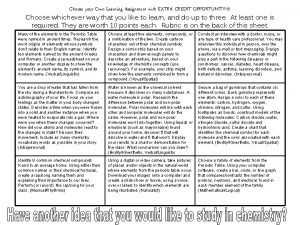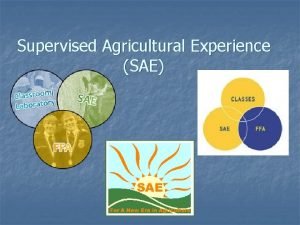Choose your Own Learning Assignment with EXTRA CREDIT


- Slides: 2

Choose your Own Learning Assignment with EXTRA CREDIT OPPORTUNITY!!!! Choose whichever way that you like to learn, and do up to three. At least one is required. They are worth 10 points each. Rubric is on the back of this sheet. Many of the elements in the Periodic Table were named in ancient times. Research the word origins of elements whose symbols don’t relate to their English names. Identify ten elements named by the ancient Greeks and Romans. Create a spreadsheet on your computer or another display to show the element’s ancient name, its symbol, and its modern name. (Verbal/Linguistic) Choose at least five elements, compounds, or a combination of the two. Create cartoon characters out of their chemical symbols. Design a comic strip based on your characters and draw enough panels to describe an adventure, based on your knowledge of chemistry concepts (use resources!). For example, your strip might show the elements combined to form a compound. (Visual/Spatial) Conduct an interview with a doctor, nurse, or any type of health care professional. You may interview this individual in person, over the phone, via e-mail or text messaging. Design questions to discover how chemicals might play a part in the following diseases or syndromes: cancer, diabetes, heart disease, birth defects, asthma, learning disorders, and behavior disorders. (Interpersonal) You are a drop of water that has fallen from the sky during a thunderstorm. Compose an autobiography of your life. Focus on your feelings as the matter in your body changed states. Describe a time when you were frozen into a solid another instance when you were heated to evaporate into a gas. Where were you when these changes occurred? How did your atoms and molecules react to the changes in state? Discuss their movement. Include as many chemistry vocabulary words as possible in your story. (Intrapersonal) Water is known as the universal solvent because it dissolves so many substances. A water molecule is polar. Research the difference between polar and non-polar molecules. Polar molecules will mix with each other and nonpolar molecules will do the same. However, polar and non-polar molecules won’t mix together. Using liquids or emulsions (such as mayonnaise) found around your home, discover 5 that will dissolve in water and 5 that won’t. Display your results in a chart or demonstration for the class. What conclusions can you draw? (Bodily/Kinesthetic, Verbal/Linguistic Secure a bag of gumdrops that contains six different colors. Each gumdrop represents one atom. Assign a color to each of these elements: carbon, hydrogen, oxygen, chlorine, nitrogen, and sulfur. Using toothpicks as bonds, construct models of the following molecules: Carbon dioxide, water, nitrogen dioxide, sulfur dioxide and hydrochloric acid. Create a chart that identifies the chemical symbol for each molecule and the color associated with each element. (Bodily/Kinesthetic, Visual/Spatial) Identify 8 common chemical compounds found in an average home. Using either their common names or their chemical formulas, create a rap/song naming them and explaining their importance to our lives. Perform (or record) the rap/song for your class. (Musical/Rhythmic) Using a digital or video camera, take pictures of places and/or objects in the natural world where elements from the periodic table occur. Download your images onto a computer and create a slide show or movie, using a voiceover or labels to identify which elements are being illustrated. (Naturalist) Choose a family of elements from the Periodic Table. Using your computer software, create a bar, circle, or line graph that compares/contrasts the number of protons, neutrons, and electrons found in each member element of the family. (Mathematical/Logical)

To earn your points, you must: Have completely followed directions given in the prompt, with neatness and awareness of student audience. It is obvious that you learned something! Presented information in an easy to read format or presentation given to class. Information must be accurate. Been completed by the due date of 11/20 Have mostly followed directions given in the prompt, or was less than neat or had moments of lack of audience awareness. You know more than you did before. Presented information in an understandable format or presentation to class, or some parts were not accurate. Were overdue by 1 -3 days. Did you follow directions? Well, you turned something in, and you learned something. Too nervous to present? Not Overdue by 4 or more days. ready to present? Well, at least you had a display? What no display? Or many parts were not accurate.



